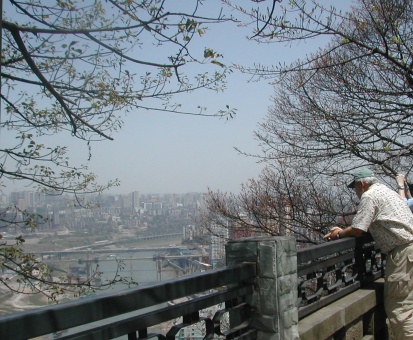CHONGQING
Chongqing became an unplanned stop for us. Our plans were to stop at the zoo to see the giant pandas then catch a midday flight to Guilin. However, we did not have enough time to make our flight, so we rescheduled to a late evening flight. That gave us an unplanned day in this city.
Until recently, Chongqing was part of the Sichuan province, but it recently became a separate city-province. It is situated on the eastern edge of the Sichuan province where the Yangtse and Jialang Rivers meet. It is a busy industrialized city with the accompanying air pollution. The population of the city itself is over 1 million, and the population of the city-province is approximately 7.5 million.
This was a depressing zoo. The animals are caged in mostly concrete cages, and there is little evidence of any effort to create any natural environment for them. There are numerous red pandas and giant pandas, but their enclosures are sorely lacking. The giant pandas, which eat only bamboo, had no bamboo growing in any of their enclosures. They were thrown a pile of cut stalks and ate them while sitting on poorly maintained grass or concrete. The bird enclosures were even worse. We were glad to have seen the giant pandas, but we really didn’t like this zoo.

Giant Panda
This small museum is the former home of General Stilwell who was based in Chongqing from 1942 through 1944 as Commander of U.S. Forces and Chiang Kai Shek’s Chief of Staff. General Stilwell led the U.S. efforts to help China repel the Japanese during World War II.
A portion of this small museum is also dedicated to the Flying Tigers who had an active presence in Chongqing during the war. The Flying Tigers were a volunteer group of U.S. fighter pilots who held off the Japanese along the China/Burma border in 1941 and 1942. We were the only Americans in our traveling group, and, not surprisingly, we were the only ones there who had heard of the Flying Tigers.
What was somewhat surprising to us was the museum’s neutral-bordering-on-favorable recognition of Chiang Kai Shek. Most of China supported Chiang when Japan invaded in 1931. When Japan seized many of China’s eastern seaports, Chiang retreated to Chongqing. He had many supporters there. Now, despite the widespread Mao worship, Chiang is still given some positive recognition in this small museum.
We took a few hours to just stroll around the old part of town. Much of it is now tourist-oriented shops, but there is also still a lot of real life left there. We wandered off a bit and walked through some old neighborhoods that had a lot of character. It gave us another opportunity to get a glimpse of how many of the Chinese people live. We particularly enjoy these spontaneous adventures.
We walked through a beautiful park overlooking the wharf district of Chaotian Men where the rivers merge, and we spent some time just sitting and relaxing – a rarity on this whirlwind trip. We were very pleased at the idea of a low-key tea ceremony – something we knew essentially nothing about.
The tea house seemed a bit more commercial than we expected, but we didn’t know any better. We enjoyed the tea ceremony itself during which we learned a bit about the history of tea and its preparation and enjoyment. We also drank some very nice tea – the best jasmine tea ever. Then the sales pitch began. Yes, we were in another state-owned shop, and the pushy sales techniques were the same. We quickly bought a package of one tea we particularly liked and got out of there as fast as possible. Is there a pattern here?
After the tea ceremony, we had dinner then went to the airport for our late flight to Guilin. We were both still about half sick, and we were getting very tired.
Follow us to Guilin or return to our China page.
Nice view of the city